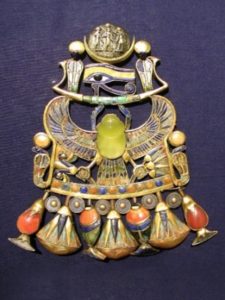
Most have heard of the treasures of the 18th Dynasty pharaoh Tutankhamun, first discovered by Howard Carter and Lord Carnarvon in 1922 when they uncovered his tomb in the Valley of the Kings in Egypt. Few are familiar with his impeccably preserved brooch, recovered along with the numerous other artifacts within the tomb. Fewer still know about the striking yellow-brown scarab that is set at its center, and that it is made of a yellow silica glass stone procured from the sand of the Sahara and then shaped and polished by ancient craftsmen. The silica glass was originally formed 28 million years ago, when an ancient comet entered the earth’s atmosphere and exploded over Egypt, heating up the sand beneath it to a temperature of about 2,000 degrees Celsius and resulting in the formation of a huge amount of the yellow silica glass, which lies scattered over a 6,000 square kilometer area in the Sahara.
The silica glass was one of a number of clues that eventually led Professor Jan Kramers of the University of Johannesburg, South Africa, and colleagues to a remarkable new discovery. At the center of it all is a mysterious black pebble found years ago by an Egyptian geologist in the area of the silica glass. After conducting highly sophisticated chemical analyses on this pebble, Professor Jan Kramers of the University of Johannesburg and a team of colleagues came to the inescapable conclusion that it represented the very first known hand specimen of a comet nucleus, rather than simply an unusual type of meteorite.
Kramers describes this as a moment of career defining elation. “It’s a typical scientific euphoria when you eliminate all other options and come to the realisation of what it must be,” he said.
“Comets always visit our skies – they’re these dirty snowballs of ice mixed with dust – but never before in history has material from a comet ever been found on Earth,” says Professor David Block of Wits University, a key researcher on the team.
________________________________________________________________________________________________________________________
An artist’s rendition of the comet exploding in Earth’s atmosphere above Egypt (credit: Terry Bakker)
______________________________________________________________________________________________________________________
The impact of the explosion also produced microscopic diamonds found within the pebble. “Diamonds are produced from carbon bearing material. Normally they form deep in the earth, where the pressure is high, but you can also generate very high pressure with shock. Part of the comet impacted and the shock of the impact produced the diamonds,” says Kramers.
The team named the diamond-bearing pebble “Hypatia” in honour of the first well known female mathematician, astronomer and philosopher, Hypatia of Alexandria.
Comet material is very elusive. Comet fragments have not been found on Earth before except as microscopic sized dust particles in the upper atmosphere and some carbon-rich dust in the Antarctic ice. Space agencies have spent billions to secure the smallest amounts of pristine comet matter.
“NASA and ESA (European Space Agency) spend billions of dollars collecting a few micrograms of comet material and bringing it back to Earth, and now we’ve got a radical new approach of studying this material, without spending billions of dollars collecting it,” says Kramers.
The discovery has not only provided the first definitive proof of a comet striking Earth millions of years ago, but it could also help unlock, in the future, the secrets of the formation of our solar system.
_____________________________
Source: Adapted and edited from a press release of the University of the Witwatersrand, Johannesburg, South Africa.
Cover Photo, Top Left: Tutankhamun’s brooch
_______________________________________________________________________________________________________________________
Read about the most fascinating discoveries with a premium subscription to Popular Archaeology Magazine. Find out what Popular Archaeology Magazine is all about. AND MORE:
 Popular Archaeology’s annual Discovery edition is a selection of the best stories published in Popular Archaeology Magazine in past issues, with an emphasis on some of the most significant, groundbreaking, or fascinating discoveries in the fields of archaeology and paleoanthropology and related fields. At least some of the articles have been updated or revised specifically for the Discovery edition. We can confidently say that there is no other single issue of an archaeology-related magazine, paper print or online, that contains as much major feature article content as this one. The latest issue, volume 2, has just been released. Go to the Discovery edition page for more information.
Popular Archaeology’s annual Discovery edition is a selection of the best stories published in Popular Archaeology Magazine in past issues, with an emphasis on some of the most significant, groundbreaking, or fascinating discoveries in the fields of archaeology and paleoanthropology and related fields. At least some of the articles have been updated or revised specifically for the Discovery edition. We can confidently say that there is no other single issue of an archaeology-related magazine, paper print or online, that contains as much major feature article content as this one. The latest issue, volume 2, has just been released. Go to the Discovery edition page for more information.
Subscription Price: A very affordable $5.75 for those who are not already premium subscribers of Popular Archaeology Magazine (It is FREE for premium subscribers to Popular Archaeology). Premium subscribers should email [email protected] and request the special coupon code. Or, for the e-Book version, it can be purchased for only $3.99 at Amazon.com.






